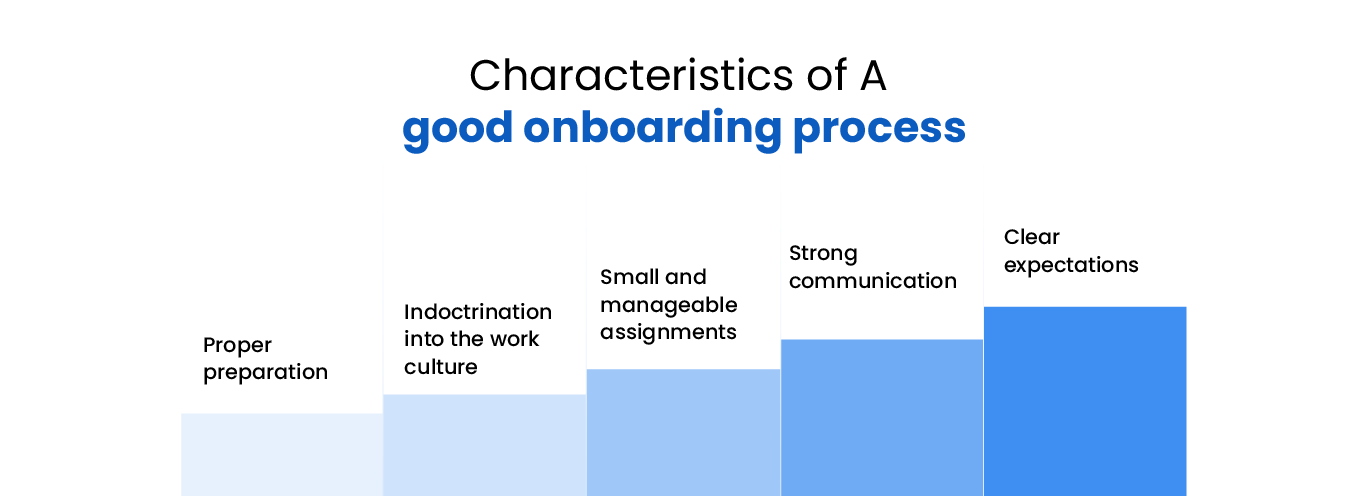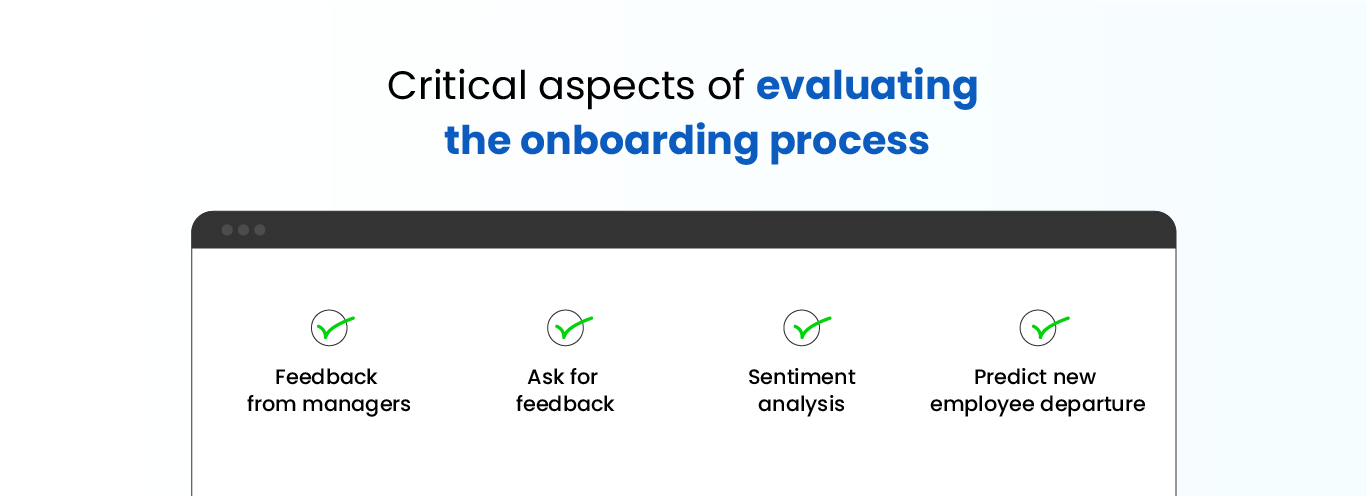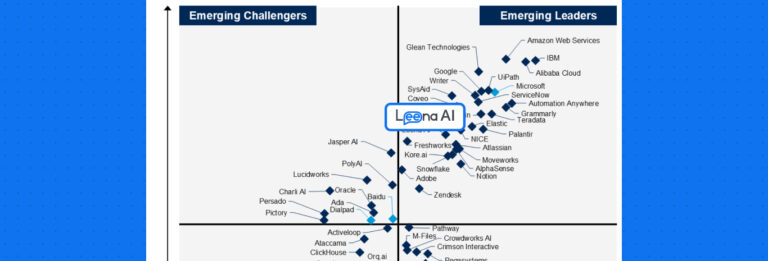Starting a new job can be overwhelming. Leaving their familiar routine and getting acquainted with a new structure takes time and a lot of effort. That is where a smooth onboarding process plays a pivotal role in making them feel welcome.
First impressions last long, and corporate is no exception. Studies show that with a positive onboarding experience, employees are more likely to stay with the organization for at least three years.
Conventional onboarding systems are no longer a good option in the current world of remote and hybrid work models. This is because the different stages of employee onboarding and their journey beyond are often neglected in traditional onboarding architecture.
Not sure what these stages are?
In today’s article, we will answer the question — “what are the 4 phases of onboarding,” and how to digitize your current system.
What are the 4 phases of onboarding?

A structured onboarding process has multifaceted benefits. On one hand, it increases employee retention significantly. On the other, it empowers the HR teams to convey the correct information in an organized way and helps new employees acclimate faster, boosting productivity.
But to ensure the above, there are four stages of an efficient employee onboarding process that every company should follow:
1. Orientation
The first step of the onboarding process is orientation. This is where new hires get introduced to the company’s senior leadership and their fellow team members. Orientation is crucial because, in the beginning, your new hires are the most uncertain of what lies ahead. That’s why it needs to be uniform across all roles to portray a clear image of your company’s mission and values.
Usually, this phase consists of the following:
- Welcome statements by senior leadership
- Overview of regulations and compliance
- Handbook of the company’s culture, history, vision, and mission
In today’s remote working structure, most companies conduct the orientation virtually. Without the face-to-face element, manually handling the welcoming efforts becomes a daunting task for HR and is also prone to human errors.
So, it is crucial to bridge the gaps and implement technology for a seamless onboarding experience. With AI-powered onboarding automation software, the correct orientation resources and elements will reach the new hires on time, without any chances of human error.
A self-paced automated approach will make the experience hassle-free for both parties, saving both time and resources
A smooth start will establish a strong base for the rest of the three phases.
2. Training
The next phase teaches the new hires about their day-to-day duties and prepares them to handle the tasks seamlessly. Practical role training is crucial for an uninterrupted workflow and the long-term success of your employees.
If you carry out this phase strategically, your new hires will be able to acclimate quickly and carry out their responsibilities with greater confidence.
Different aspects of role training include:
- Reviewing performance expectations
- Technical and process training
- Safety training
- Job shadowing
In this phase, interactive AI software can come in handy. With virtual reality, you can capture the interest of new hires and keep them engaged in the learning process. The absence of formula-ridden instruction manuals and the inclusion of simulation will raise the training process. Learners will gain practical experience working in automated simulation and practicing safety measures. The process of leveraging technology to deliver job training also adds to the positive onboarding experience.
3. Transition
This phase helps the new hires transition to full-fledged employees of the organization. Their direct supervisor becomes their primary source of guidance and support as the managers and front-line leaders are equipped with the necessary skills to support new hires.
Essential elements of this phase include
- Strategies for growth and advancement
- Effective communication
- Importance of authenticity
As a business leader, you should encourage your managers to set clear expectations so that the new hires properly comprehend their responsibilities. Leveraging technology will allow HRs to experience the impact of their decisions in a simulation so that they can identify what will work and what will not. Practicing such activities with AI-powered onboarding software will also help the managers and supervisors to fine-tune their soft skills regarding employee management.
4. Ongoing development
Onboarding does not end at transition. The future growth plan for your new employees is also critical to making the structure efficient.
With a well-developed long-term plan, your new employees can visualize how they can contribute to the organization’s future goals and grow within the company. This way, both the employer and the employee can reach their aspirations without their interests colliding with each other.
This phase includes
- Career mapping
- Competency assessment
- Clear professional and personal goals
- Individual development plans
With effective onboarding software, you can get reports and assessments of every new employee’s performance and identify their strengths. This will help you determine the areas where a particular employee can contribute the most and set reasonable professional and personal goals and development plans for each employee and precise career mapping.
What are the characteristics of a good onboarding process?

Onboarding is the employer’s turn to portray a positive image of the company to the new hires. According to a survey, only 28% of employees reported that their onboarding process was smooth and satisfactory, while 22% did not go through an onboarding process.
So what characteristics should be there in the different stages of employee onboarding?
1. Proper preparation
A thorough preparation is essential to make your new hires feel welcome and appreciated on their first day. Ensure all the relevant resources, tools, and meeting invitations are in place so that they can be delivered chronologically.
Check if the HR systems are adequately equipped to handle the necessary paperwork and deliver any vital documentation. This will save you time when the onboarding process begins and allow your new hires to experience hassle-free onboarding.
2. Indoctrination into the work culture
Let your new hires get an idea of the company’s work culture on the first day. This will help them acclimate quickly and give them an idea of how the company conducts its day-to-day business. Schedule meetings with team members to convey the functions and responsibilities. Let them know that questions will be appreciated.
3. Small and manageable assignments
Overwhelming responsibilities on the very first day can stress the new joiner. On the other hand, lesser work can be demoralizing. So you must strike a balance and assign small but manageable tasks to freshly-recruited employees.
The onboarding day could include tasks like basic use of the equipment and parts of specific assignments. If the new hire’s responsibilities include interacting with clients, giving them a basic idea about the customers and the best ways to communicate with them can work wonders.
4. Strong communication
Initiatives to build strong communication between the new employee and their team members should start on day one. AI-powered tools and collaborative platforms can support employees in building a bond with their particular team, leading to better collaboration on assignments.
5. Clear expectations
You must structure your onboarding process to portray the company’s future goals comprehensively. Each employee must develop a clear idea of what is expected and what they need to achieve in a given timeframe, along with a plan of action.
What are some critical aspects of evaluating the onboarding process?

Let us look at the significant elements involved in assessing an onboarding process:
1. Feedback from managers
Managers act as the link between leadership and employees. They supervise the workforce and understand employee-related issues better than the senior leadership. So to know how exactly onboarding is viewed at your company, carry out a quick survey of managers. If you do not get consistent answers across departments, note that it is precisely where you need to take action to provide a unified experience and get everybody on the same page.
2. Ask for feedback
At the end of the first day, ask for feedback from your new hires on their onboarding experience. The questions should be developed around their worries or concerns, giving new employees a chance to share what they need for success.
Quick pulse surveys can help you here. They take only a few minutes to finish but provide substantial insight into your new hire’s onboarding experience. With short and straightforward pointed questions, it prevents employees from dropping out in the middle, increasing participation and saving time. It also helps you improve your onboarding process and update it.
Leena AI’s automated pulse surveys deliver real-time actionable insights that help organizations make the first day of work seamless and assist new employees to feel comfortable and welcome.
3. Sentiment analysis
Taking feedback at face value does not provide the whole picture. But with appropriate AI technology in place, you can dig deeper to understand the sentiment of the new hires and structure a plan accordingly.
With Leena AI, you can decipher in-depth insights from open-ended employee feedback. The analytics will help you quickly understand the pain points of your employee onboarding strategy and bridge the gaps.
4. Predict new employee departure
With proper HR analytics, you can predict which new hires are at risk of leaving the company and take measures accordingly. It will also help you pinpoint what parts of the different onboarding phases did not work for them, allowing you to improve in the future and maintain a high retention rate.
Conclusion
While wrapping up today’s discussion, it is essential to point out that just thoroughly planning out stages of employee onboarding is not enough. HRs need to monitor the different onboarding phases for constant improvement.
Leveraging technology is the key to streamlining your onboarding strategy, but it also involves including and handling a fair number of new features in the system.
The onboarding process in a remote working model needs constant looking into, and thus it is imperative to choose a powerful solution such as Leena AI. It provides automated engagement workflows and surveys during onboarding to equip you with real-time issue resolution during a new hire’s journey with the organization.
Leena AI’s powerful software analyzes employee sentiments from their feedback and generates comprehensive reports on the areas that need improvement for a better onboarding process. The automated system also helps HR by efficiently handling all documentation without HR teams handling lengthy paperwork.
A well-structured onboarding process plays a crucial role in retaining the best employees. So, to integrate effectiveness in all four phases of employee onboarding quickly and give your new hires a warm and hassle-free welcome, get started with Leena AI today.






